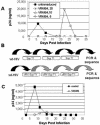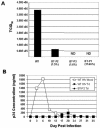Antisense-mediated inhibition of human immunodeficiency virus (HIV) replication by use of an HIV type 1-based vector results in severely attenuated mutants incapable of developing resistance
- PMID: 15194784
- PMCID: PMC421644
- DOI: 10.1128/JVI.78.13.7079-7088.2004
Antisense-mediated inhibition of human immunodeficiency virus (HIV) replication by use of an HIV type 1-based vector results in severely attenuated mutants incapable of developing resistance
Abstract
We have constructed a human immunodeficiency virus type 1 (HIV-1)-based lentiviral vector expressing a 937-base antisense sequence against the HIV-1 envelope gene. Transduction of CD4(+) T lymphocytes with this vector results in expression of the therapeutic antisense sequence and subsequent inhibition of productive HIV-1 replication. In this report, we examined the effect of antisense-mediated suppression on the potential development of virus escape mutants using a permissive T-cell line cultured under conditions that over serial passages specifically allowed for generation and amplification of mutants selected for by antisense pressure. In the resulting virus clones, we found a significant increase in the number of deletions at the envelope target region (91% compared to 27.5% in wild-type HIV). Deletions were most often greater than 1 kb in length. These data demonstrate for the first time that during antisense-mediated suppression of HIV, mutants develop as a direct result of selective pressure on the HIV genomic RNA. Interestingly, in clones where deletions were not observed, there was a high rate of A-G transitions in mutants at the antisense target region but not outside this region, which is consistent with those mutations that are predicted as a result of antisense-mediated modification of double-stranded RNA by the enzyme double-stranded RNA-specific adenosine deaminase. These clones were not found to be escape mutants, as their replicative ability was severely attenuated, and they did not replicate in the presence of vector.
Figures





Similar articles
-
Inhibition of simian/human immunodeficiency virus replication in CD4+ T cells derived from lentiviral-transduced CD34+ hematopoietic cells.Mol Ther. 2005 Dec;12(6):1157-67. doi: 10.1016/j.ymthe.2005.07.698. Epub 2005 Sep 15. Mol Ther. 2005. PMID: 16168713
-
Enhanced inhibition of human immunodeficiency virus type 1 replication by novel lentiviral vectors expressing human immunodeficiency virus type 1 envelope antisense RNA.Hum Gene Ther. 2002 Jun 10;13(9):1027-37. doi: 10.1089/104303402753812430. Hum Gene Ther. 2002. PMID: 12067436
-
Inhibition of HIV-1 replication by novel lentiviral vectors expressing transdominant Rev and HIV-1 env antisense.Gene Ther. 2002 Apr;9(7):421-31. doi: 10.1038/sj.gt.3301674. Gene Ther. 2002. PMID: 11938457
-
Anti-HIV-1 gene expressing lentiviral vectors as an adjunctive therapy for HIV-1 infection.Curr HIV Res. 2004 Apr;2(2):185-91. doi: 10.2174/1570162043484906. Curr HIV Res. 2004. PMID: 15078182 Review.
-
The level of CD26 determines the rate of HIV entry in a CD4+ T-cell line.Adv Exp Med Biol. 1997;421:179-84. doi: 10.1007/978-1-4757-9613-1_23. Adv Exp Med Biol. 1997. PMID: 9330695 Review.
Cited by
-
Bone Marrow Gene Therapy for HIV/AIDS.Viruses. 2015 Jul 17;7(7):3910-36. doi: 10.3390/v7072804. Viruses. 2015. PMID: 26193303 Free PMC article. Review.
-
Survival of the fittest: positive selection of CD4+ T cells expressing a membrane-bound fusion inhibitor following HIV-1 infection.PLoS One. 2010 Aug 23;5(8):e12357. doi: 10.1371/journal.pone.0012357. PLoS One. 2010. PMID: 20808813 Free PMC article.
-
The utility of the new generation of humanized mice to study HIV-1 infection: transmission, prevention, pathogenesis, and treatment.Retrovirology. 2011 Aug 11;8:65. doi: 10.1186/1742-4690-8-65. Retrovirology. 2011. PMID: 21835012 Free PMC article. Review.
-
Analysis of lentiviral vector integration in HIV+ study subjects receiving autologous infusions of gene modified CD4+ T cells.Mol Ther. 2009 May;17(5):844-50. doi: 10.1038/mt.2009.16. Epub 2009 Mar 3. Mol Ther. 2009. PMID: 19259065 Free PMC article.
-
Exploiting Genetic Interference for Antiviral Therapy.PLoS Genet. 2016 May 5;12(5):e1005986. doi: 10.1371/journal.pgen.1005986. eCollection 2016 May. PLoS Genet. 2016. PMID: 27149616 Free PMC article. Review.
References
-
- Baum, C., J. Dullmann, L. Zhixiong, B. Fehse, J. Meyer, D. A. Williams, and C. von Kalle. 2003. Side effects of retroviral gene transfer into hematopoietic stem cells. Blood 101:2099-2113. - PubMed
-
- Behrens, G. M., M. Stoll, and R. E. Schmidt. 2000. Lipodystrophy syndrome in HIV infection. What is it, what causes it, and how can it be managed? Drug Safety 23:57-76. - PubMed
-
- Centers for Disease Control and Prevention. 2002. Cases of HIV infection and AIDS in the United States, 2002. HIV/AIDS surveillance report, vol. 14. CDC Division of HIV/AIDS Prevention, Atlanta, Ga.
MeSH terms
Substances
LinkOut - more resources
Full Text Sources
Other Literature Sources
Medical
Research Materials

